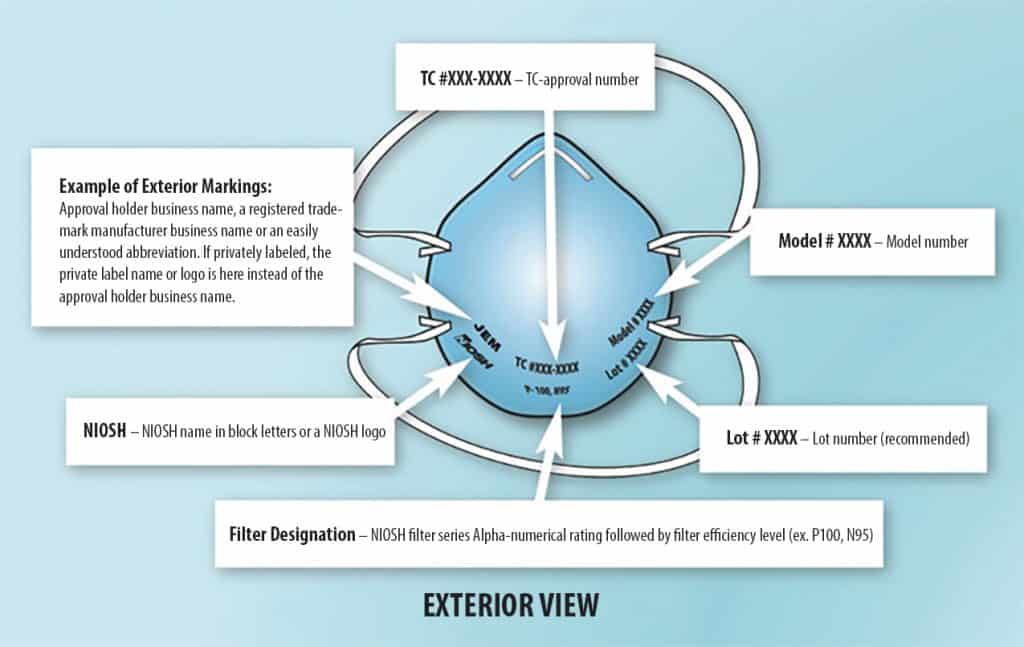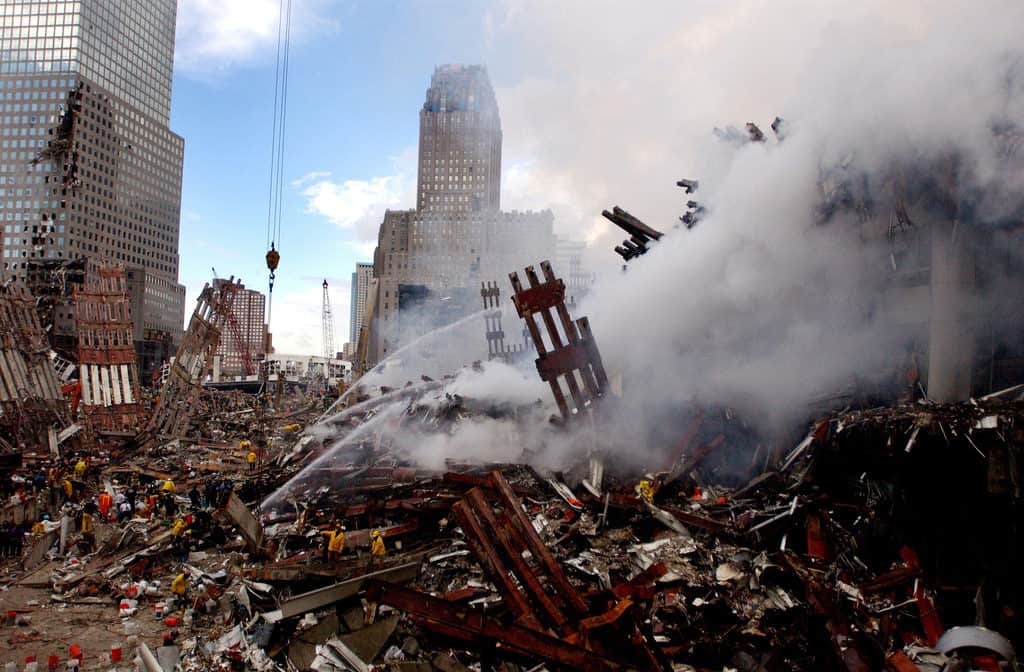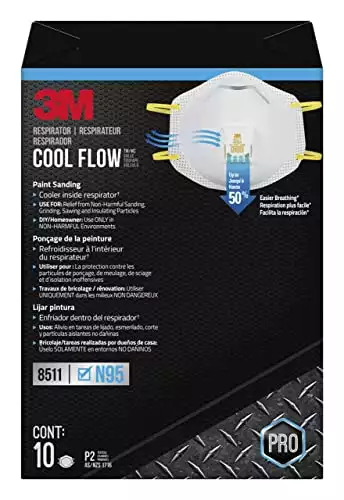One of the most important yet most overlooked emergency preparedness items is an N95 face mask. There is a lot of confusion about whether N95 masks work for emergencies and how to use them properly, so I thought I’d address the issue here.
What is an N95 Mask?
An N95 mask (also called a respirator) is a mask that is worn over the face to prevent the inhalation of airborne particles. The N95 designation means the mask will filter at least 95% of particles 0.3 microns in size.
Surgical Mask vs. N95 Mask
N95 masks look much like surgical masks, but they are very different. Do not get a surgical mask and think it will protect you against germs and airborne contaminants!
- Surgical masks are designed to protect the environment from the wearer. For example, doctors wear them during surgery to prevent germs in their breath from getting into the patient.
- N95 masks protect the wearer from the environment. So, a person could wear them in a hospital to reduce the likelihood of catching someone else’s germs.
- Surgical N95 Masks: These are masks that give the protection of both surgical masks and N95 masks. If you are sick, they will prevent your germs from being transmitted while protecting you from breathing them in. They have been approved by NIOSH and the FDA.
(Sources: Oxford Journal, NCBI)

Face Masks Ratings and Certifications
Never buy a face mask unless it has been approved by the National Institute for Occupational Safety and Health (NIOSH) or meets the European Standard.
N95 is the most common NIOSH face mask rating in hardware stores and online. However, there are also other ratings.
NIOSH Face Mask Ratings
- N95: Will filter at least 95% of airborne particles; not resistant to oil
- N99: Will filter at least 99% of airborne particles; not resistant to oil
- N100: Will filter at least 99.97% of airborne particles; not resistant to oil
- R95: Will filter at least 95% of airborne particles; somewhat resistant to oil
- P95: Will filter at least 95% of airborne particles; very resistant to oil
- P99: Filters at least 99% of airborne particles. Strongly resistant to oil.
- P100: Filters at least 99.97% of airborne particles. Strongly resistant to oil.
European Standard
The European Standard uses the certification “EN-149” and not the NIOSH certification. There are three main levels of EN-149 ratings.
- P1 EN-149 Face Masks: Filters 80% of airborne particles
- P2 EN-149 Face Masks: Filters 94% of airborne particles
- P3 EN-149 Face Masks: Filters 99.5% of airborne particles
Source: CDC
Yes, the Rating Matters!
Do NOT buy very cheap face masks that haven’t been approved! Those cheap face masks might not provide you with any real protection. Consider these study results from NIOSH and the CDC:
| Respirator/Mask Type | Polydisperse Aerosol Test
(PAT) (%) | Monodisperse Aerosol Test (MAT) (%) (40 nm) |
| NIOSH N95 | 98.76 – 99.39 | 94.80 – 98.00 |
| NIOSH P100 | 99.978 – 99.997 | 99.991-99.993 |
| FDA Surgical Mask | 11.94 – 98.42 | 27.49 – 91.02 |
| Unregulated Dust Mask | 12.98 – 99.00 | 18.37 – 95.69 |
Yes, some unregulated dust masks might provide protection – but you have no way of knowing if it doesn’t have the NIOSH or a European Standard rating.
Do N95 Masks Protect You from Hazards?
There is a lot of confusion and controversy about whether N95 masks protect wearers. As with many things related to emergency preparedness, there is no one answer here. It depends on the type of emergency in question.
N95 masks will protect against at least 95% of airborne particles 0.3 microns in size. To give you an idea of how small 0.3 microns is, consider these particle sizes:
- Anthrax: 1-5 microns
- Abestos:7-90 microns
- Bacteria:3-60 microns
- Car emissions: 1-150 microns
- Burning wood: 2-3 microns
- Coal dust: 1-100 microns
- Household dust: 05-100 microns
- Mold: 3-12 microns
- Pesticides and herbicides: 001 microns
- Skin flakes: 5-10 microns
- Plant spores: 3-100 microns
- Smoke from synthetic materials: 1-50 microns
- Viruses: 005-0.3 microns
As you can see from these particle sizes, an N95 mask will protect against larger particles in the air, such as in situations with a lot of dust. For example, it would be wise to wear an N95 face mask when cleaning up debris from a natural disaster.
Even though viruses are often smaller than 0.3 microns, there is ample evidence which shows that N95 masks do protect against viruses.
If you or people around you have a virus, wearing an N95 face mask can help. However, during a major viral outbreak, you’d be safer with a higher level of protection than what the N95 masks can offer.

N95 Masks Are Useless Against Chemicals and Gases
What preppers want to know is whether an N95 mask would work against biological or chemical attacks. Of how much protection they will provide, Defense Analyst Victor Utgoff says:
Not much, but better than nothing.
If a bioterrorism attack were to occur, the bacteria would likely be dispersed in particle form, so wearing an N95 mask might help. However, Utgoff goes on to say that:
Against chemical attack and gas, (N95 masks are) worthless.
You’d need a much more sophisticated face mask with a cartridge for those sorts of attacks.
The N95 Mask Has to Fit Right to Be Effective!
If you wear an N95 mask, you must ensure it fits correctly. Otherwise, the face mask will be virtually worthless because of all of the leakage that will occur.
N95 face masks are NOT recommended for children or people with facial hair. If you have facial hair and want protection from your N95 mask, you must duct tape it around your head. It’s not very comfortable, but better than breathing in asbestos, bacteria, mold and other pathogens!
How to Make Sure the Respirator Fits
When the respirator is fitted and on correctly, it will form a seal around your face. Here’s how you can check the seal:
- Negative Pressure Check: Put both hands over the N95 mask and breathe in deeply. The N95 mask should pull towards your face. You’ll be able to see the mask slightly collapsing. No air should escape.
- Positive Pressure Check: Now breathe out deeply. If your mask has an exhalation valve, you’ll want to cover this valve when doing the test. Make sure you don’t feel any air leaking out.
If you can’t create a proper seal with the N95 mask, then you need to try a different size or model. You should TEST YOUR N95 MASK FIT BEFORE AN EMERGENCY OCCURS! You don’t want to wait until disaster strikes to discover that you’ve got the wrong size mask!
Source: NY Health
Tip: Buy N95 masks which have a metal nosepiece. The nosepiece can be bent to fit your nose and provide a better fit.
 3M 8511 Respirator N95
3M 8511 Respirator N95
For most disaster situations where pollution is in the air, an N95 mask is your smartest choice.
They are affordable but highly effective at filtering out particles.
The Bottom Line on N95 Masks?
When it comes to emergency preparedness, N95 masks are far from perfect. If fitted properly, they protect you from particles like mold, dust, bacteria, and viruses. However, they aren’t going to protect you from chemical or gas attacks.
If you can afford it, I’d recommend getting a full-face cartridge mask (aka gas mask). However, keep some N95 masks with your emergency supplies, too! The N95 masks are much cheaper and a heck of a lot less conspicuous to wear.
You can find a list of NIOSH-approved N95 masks here.
Do you have an N95 mask or other respirator in with your emergency supplies? Let us know your thoughts on this in the comments.


I ordered some “5 layer” pm2.5 filters for use as cotton mask inserts, but what I received had only 3 layers. Are they totally useless? Thanks
Those filters are meant for pollution and not viruses. However, they are made from melt-blown fabric which is the same type of material used in N95 masks and works by tangling particles in the fibers. Obviously the PM2.5 filters aren’t going to be as good as an N95 mask. However, if you don’t have any alternative, I’d say that the PM2.5 filter (whether it’s 3 or 5 layers) is better than just cotton. Make sure the mask fits tightly though or it won’t be protecting YOU but rather the people around you.
What it comes down to is that the N-95 will stop most but not all covid-19. It will stop most, but not all particulates for which it is rated. It is important to note that a proper fit is key to achieving maximum protection. It is also important to note that the N-95 does NOT protect you from expelled biological material that impacts your eyes. Even face shields are not totally effective.
The next step up is a Cartridge Air Purifying Respirator. They come in full face and half face models. Cant see any reason to bother with the half face model… These can be equipped with cartridges that are effective against multiple hazards including many but not all, chemical, biological, and nuclear challenges.
Selection of the appropriate protection is an acquired skill and is well beyond the average persons ability… Please note that this doesn’t include the full ensemble that is required to protect you from anything beyond inhalation injury. Remember that skin is the largest organ of the body and it needs to be appropriately protected as well.
If a person needs protection beyond this level their chances of survival are likely nil.
I could go on for some time, but I think (HOPE) I made my point.
Lots of good points there! I think a lot of us preppers are constantly debating these issues and questioning how much protection is reasonable and how bad of SHTF situations do we want to prep for. Thanks for the comment!
Is it normal that a new N95 has a strong chemical odor for a short while after opening the plastic packaging? These are 3M 9501V made in China, no NIOSH logo.
Would like to know how to make the masks.
What’s fabrics are are
acceptable
Anything you can help me out with.
My daughter is a RN and she says they WILL BE OUT TODAY!!
I can make them if you can get me the details.
Have you found anything ? Also looking
Post here should help – Homemade N95 Mask
No, It’s not about the direction the air is traveling through the mask, it’s mainly the fact that the edges do not seal around your face, allowing you to breathe in air from the sides. But any barrier is better than no barrier, so if that’s all you got, roll with it. You can try taping up the sides to your face, but who knows what size particles can still get through that fabric. Still better than nothing. I saw a website suggesting a couple pieces of facial tissue inside a surgical mask.
What if you turned the surgical masks around, with the inside out. Would that help prevent stuff from getting in?
Under NIOSH Face Mask Rating N99 & N100 are listed as not oil resistent then below they are listed again as oil resistent. Did you mean P99 & P100 for the oil resistent?
Thanks for catching that typo – have amended.
I do not understand why surgical masks will not work. I understand that they are designed to keep germs from patients. It just seems intuitive that if they keep germs in they will also keep getms from the mask wearer.
If the size of the coronavirus is currently unknown, how does anyone know if the N95 will protect against it?
I think Coronavirus are usually 0.1 to 2 microns,
Making the N95 masks useless…
But Coronavirus often binds to other bigger particles (like mucus), and N95 masks works 95% then.
So N95 masks can offer some protection, it’s be better than nothing… But they certainly aren’t made to protect against Coronavirus.
I think N100 masks offer the right protection.
There is a serious misunderstanding here about how filters work. The .3 µm rating is the worst case particle size. Particles larger than this would obviously be filtered out more, but particles smaller than this are also filtered out more due to molecular diffusion.
SARS-Co-V2 is on the order of 0.1 micron. However, the primary mode of transmission is from aerosolization of bodily fluid via a cough or a sneeze. These liquid droplets are much larger, on the order of 72 microns, and thus will be captured by the mask.(https://www.ncbi.nlm.nih.gov/pmc/articles/PMC3785820/)
Very informative…thanks
So, what about kids?
Very few quality N95 masks available for kids, you can get kids gas masks which may be suitable – read this post for more info on the different types of gas mask
3M 1860S is a small version of a standard 3M 1860 N95 rated mask/respirator .That mask will be as close to a child size ” off the shelf” mask that you will probably find ,unless special ordering from 3M or another supplier.
Whenever available, for personal safety I’d recommend wearing a proper N95/3M mask instead of making a DIY one. On a positive note, children aren’t healthcare workers so buying child-sized masks isn’t contributing to any shortages of PPE for medical workers.
My husband is a registered nurse in USA Arizona. He is working every day wearing only a surgical mask. His employer has not provided proper PPP. Does anyone know where I can buy an N-95 for a licensed healthcare professional?
Amazon has a section just for frontline workers like him. I don’t know any “secret sources” yet.